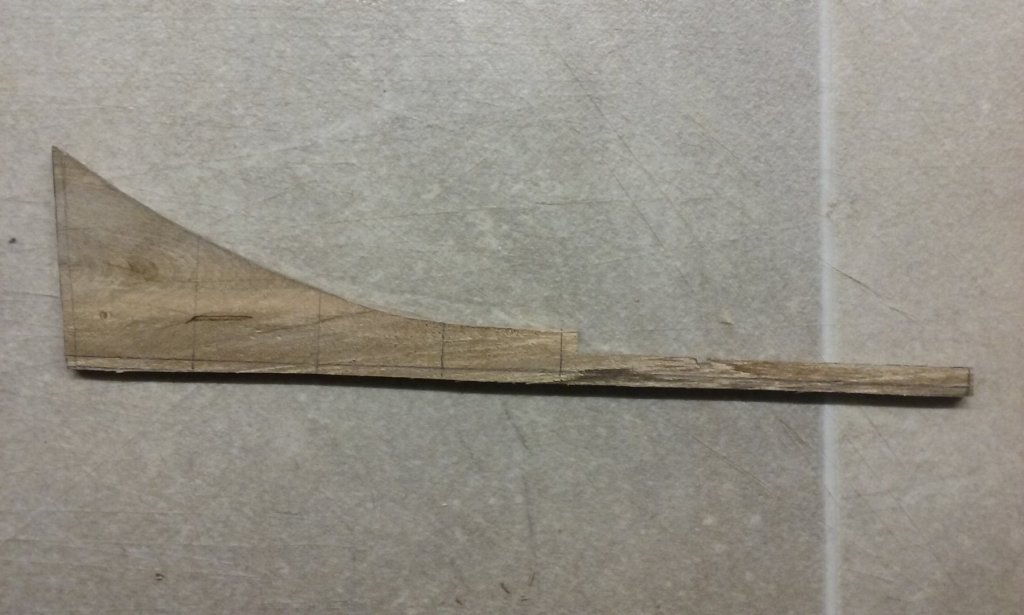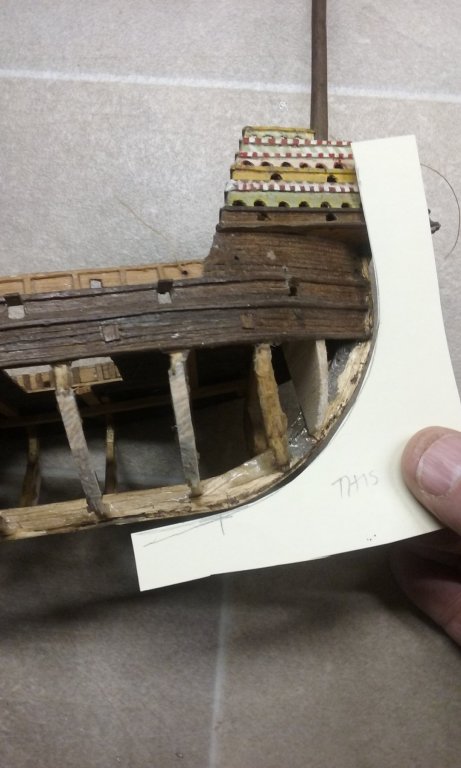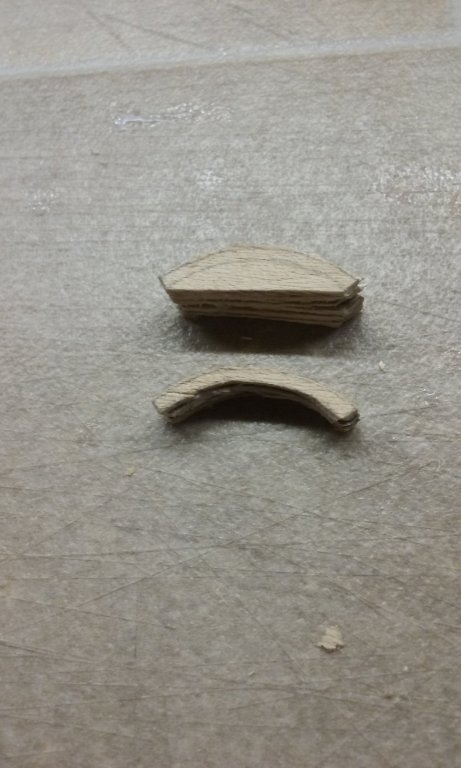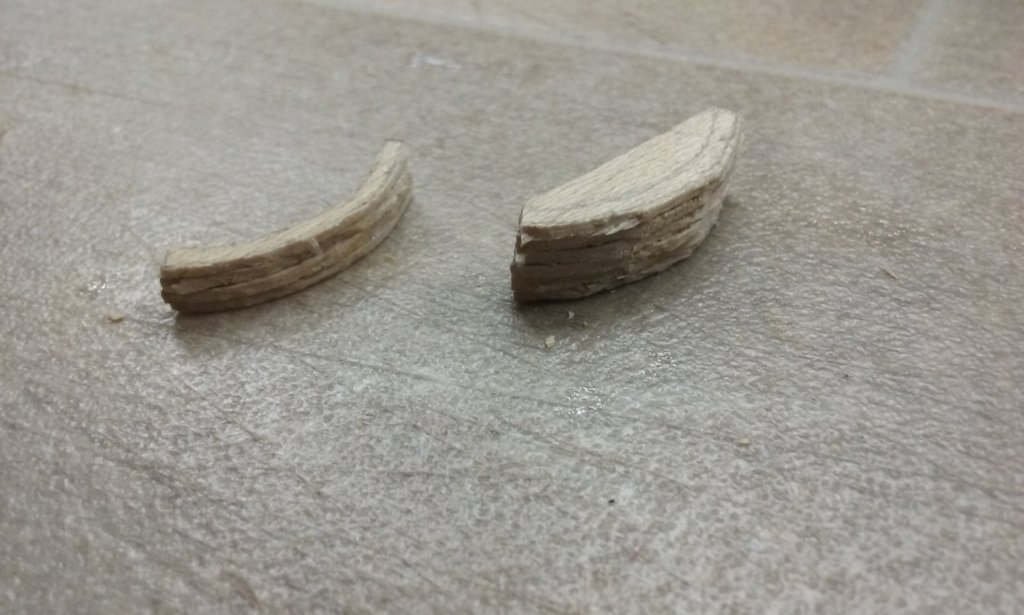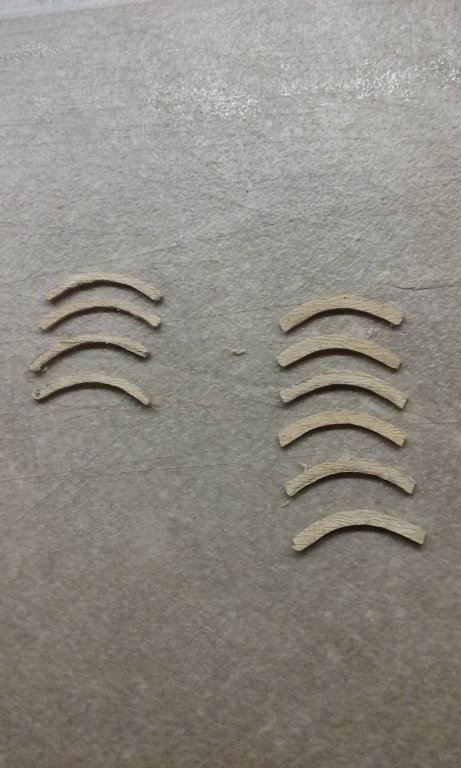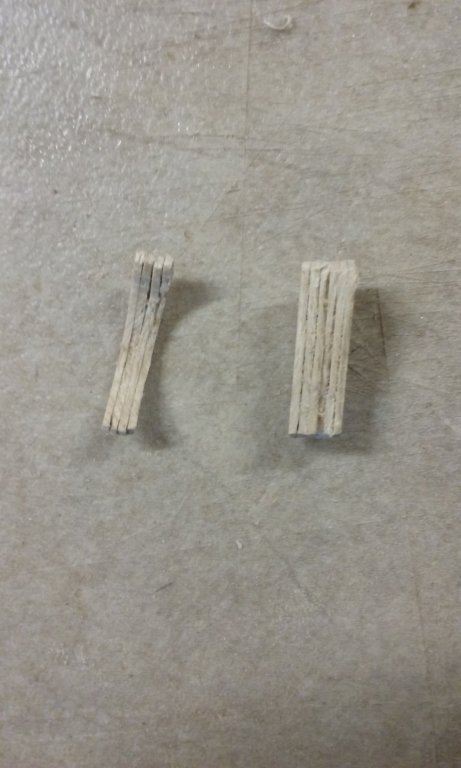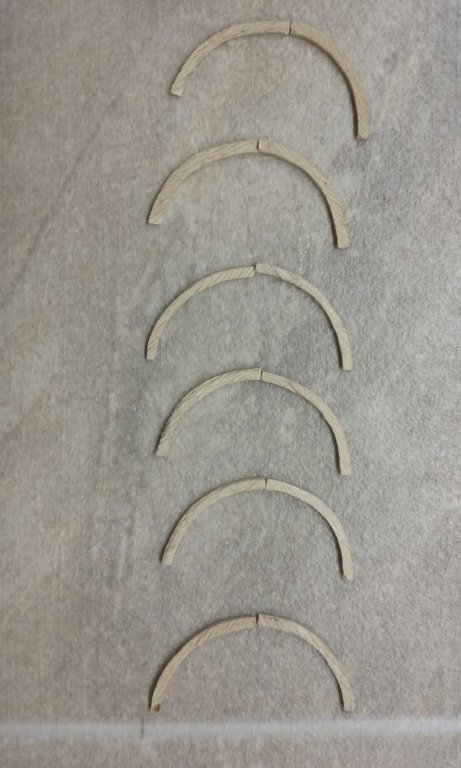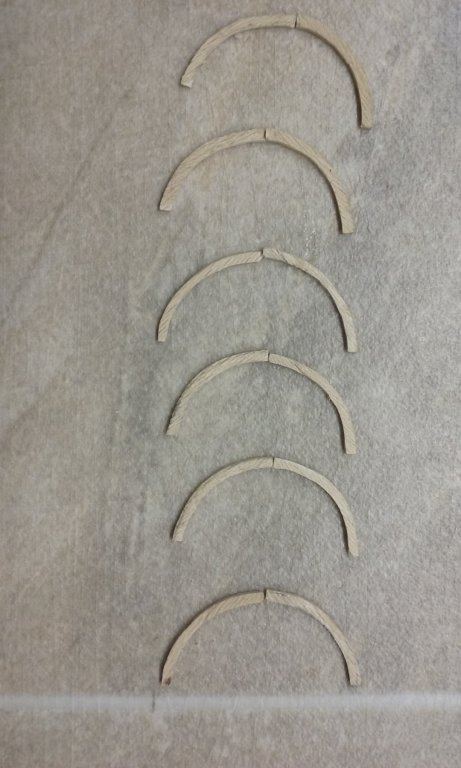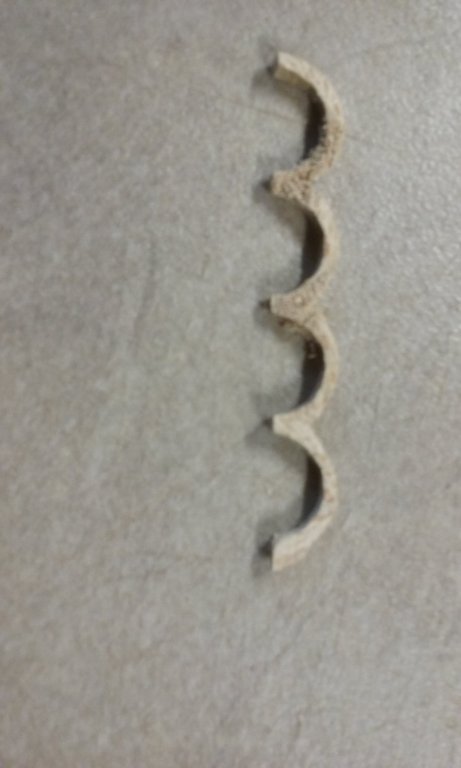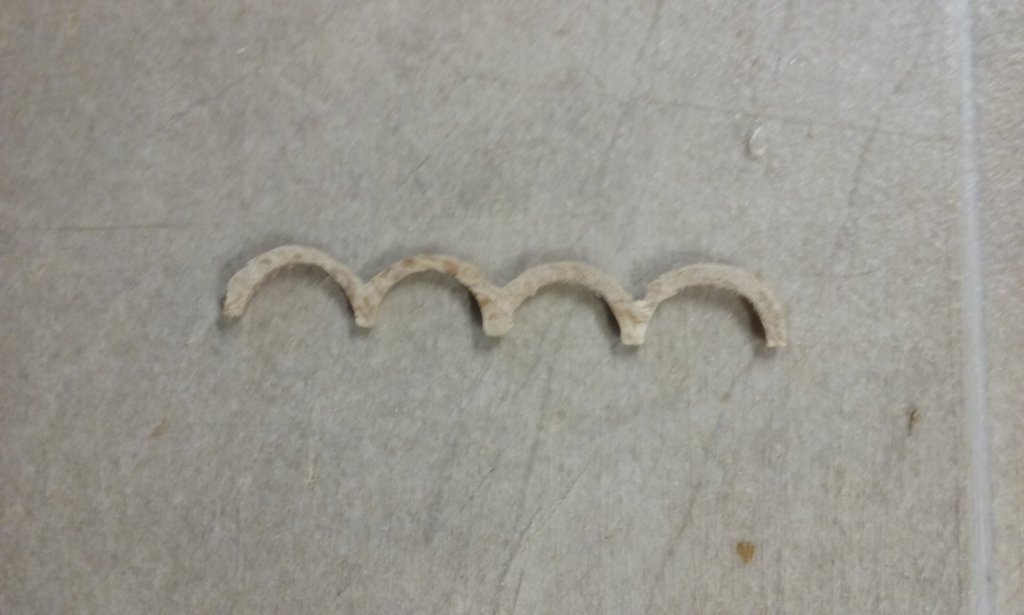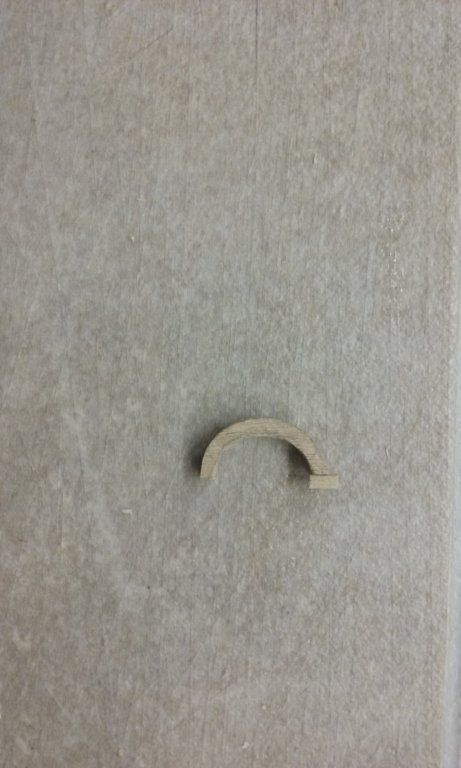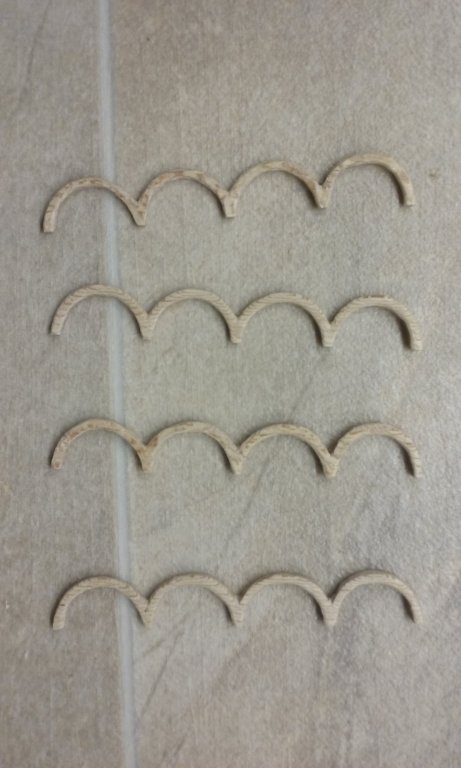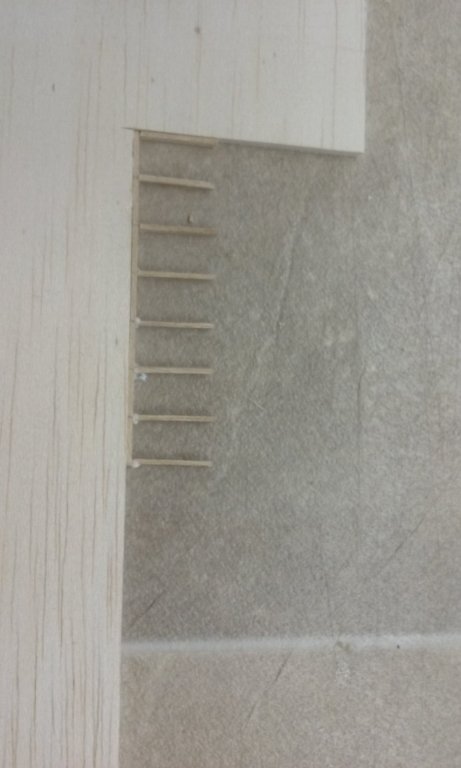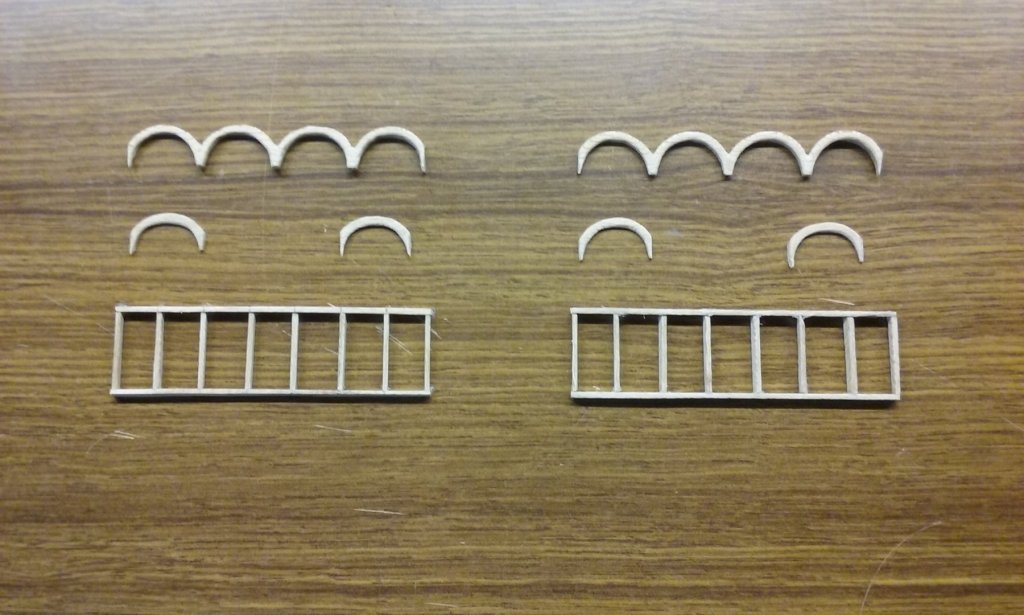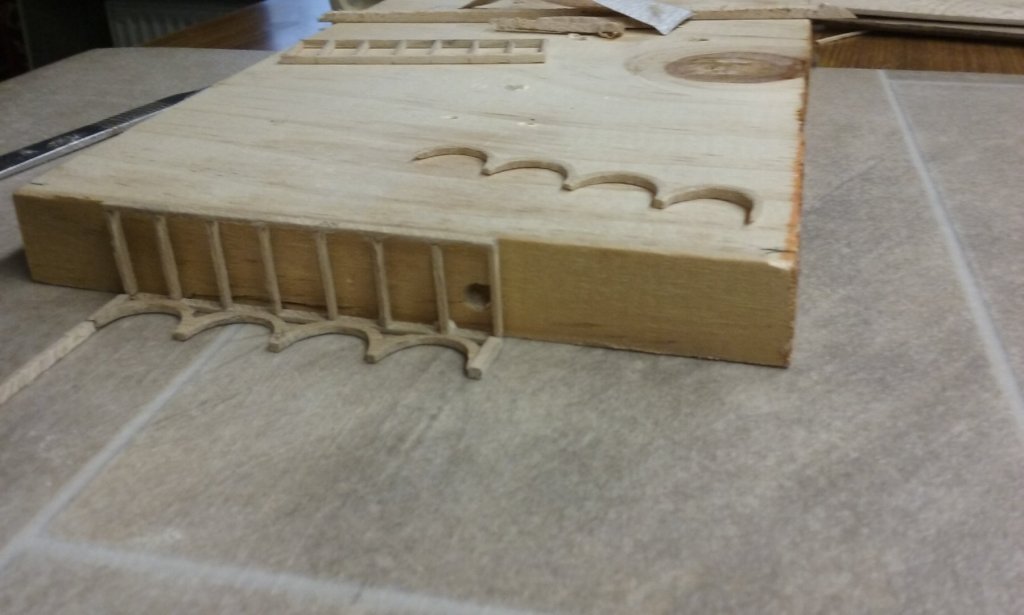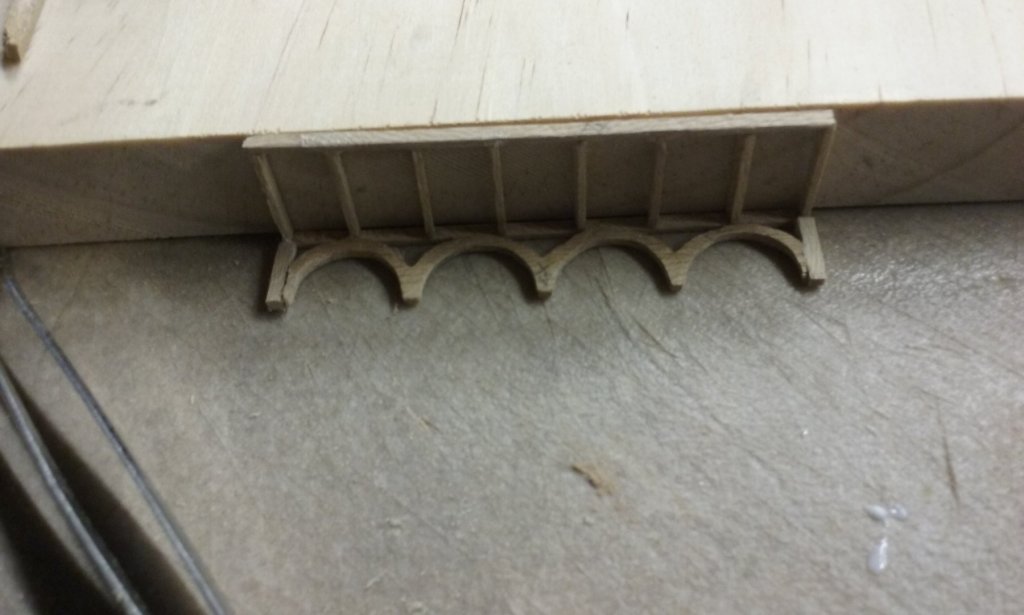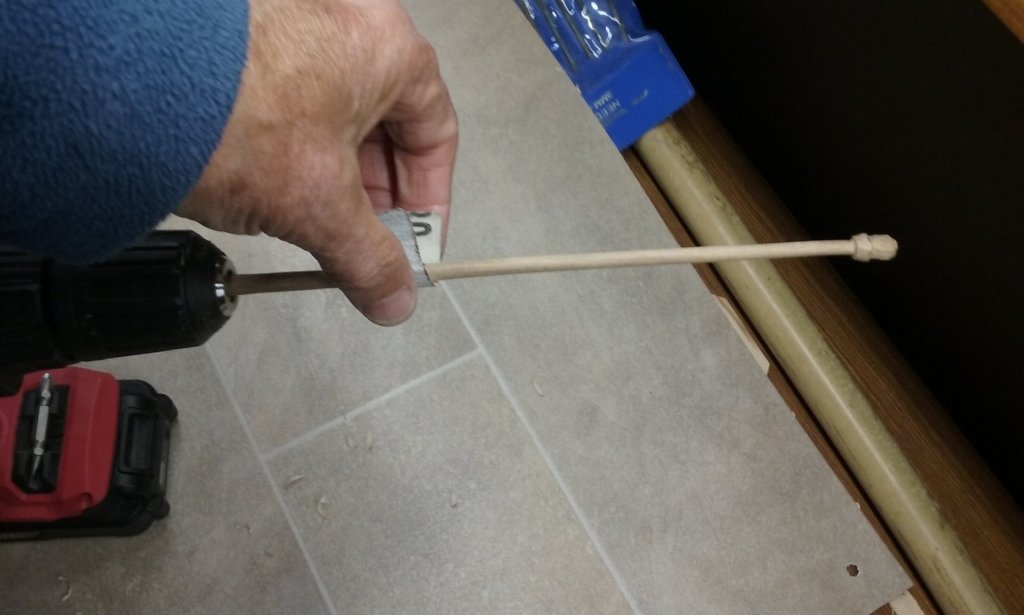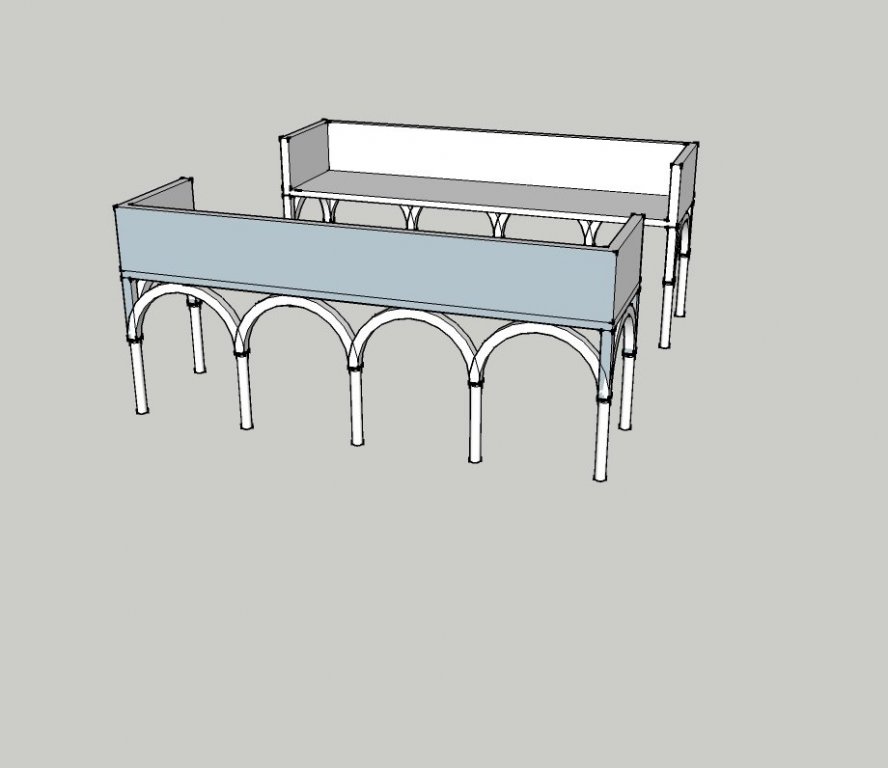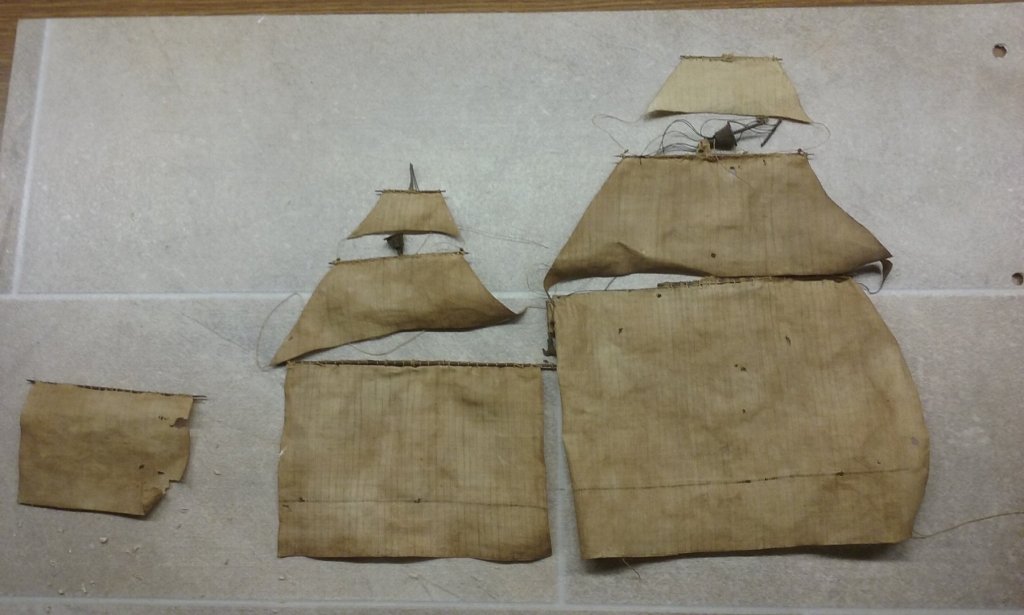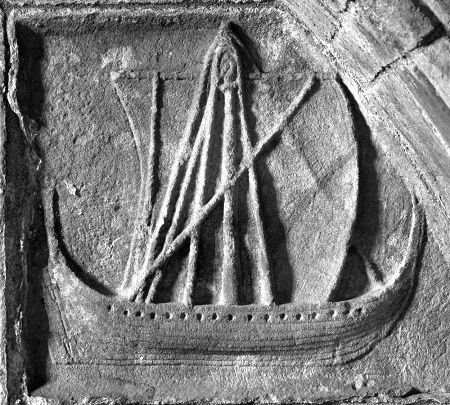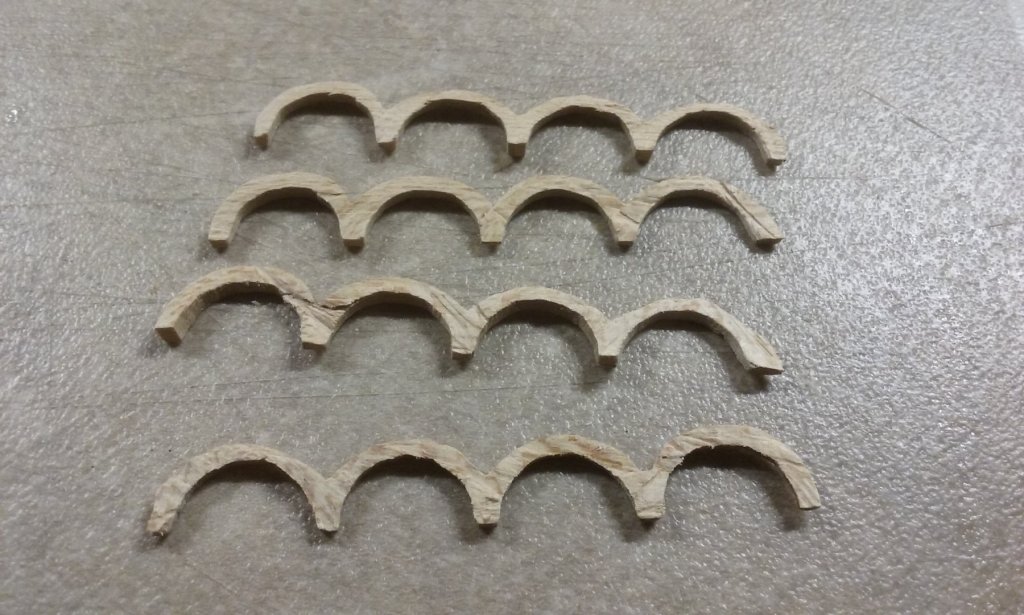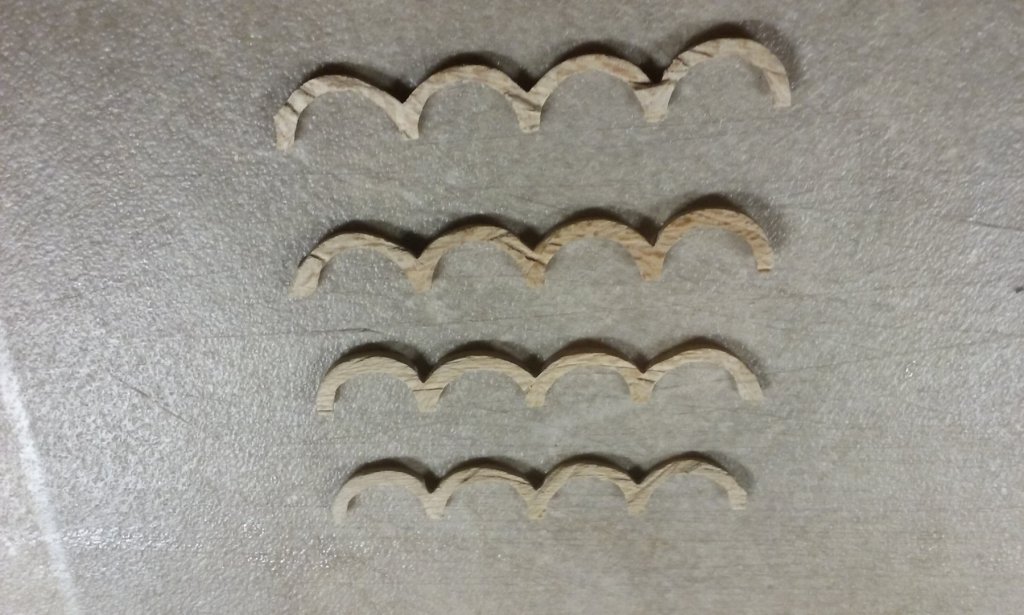-
Posts
7,989 -
Joined
-
Last visited
Content Type
Profiles
Forums
Gallery
Events
Everything posted by Louie da fly
-
Sometimes when I'm working away at the dromon build, I look over at the Great Harry looking all forgotten and neglected and have a bout of conscience. So I've done a bit more in the last couple of days. I'd always intended to replace the balsa keel with something a bit more decent, so here are a few photos of what I've been doing. The keel re-made in walnut (from the dead tree next door, kindly donated by the neighbour) Despite the look of the photo, there isn't really a great gouge out of the keel. It's just a weird reflection from the timber. I made it out of a single piece of wood, as I'm trying to replicate my state of knowledge and skill when I originally built the model at the age of 17. I have introduced a few changes in the light of my current (hopefully more advanced) understanding, but not too many. And making up a cardboard template for the stempost. Quite a lot of failed attempts but finally got the shape right. PS: Druxey, in case you didn't see it in the dromon build, I've discovered isoproanol is MUCH better than metho for dissolving PVA. Ah well, another theory down the drain. Steven
- 740 replies
-
- Tudor
- restoration
-
(and 4 more)
Tagged with:
-
Thanks, Dick. That makes a lot of sense. Steven
- 263 replies
-
- nave tonda
- round ship
-
(and 2 more)
Tagged with:
-
Some photos I omitted to include in the last post but one, showing the procedure used in making the arches for the awning over the poop. The first photos show one set of blanks glued together and cut roughly to shape, plus a set formed into half-arches And the half-arches separated ready for fine shaping. The last photo (same as in post #561 above) shows the half-arches dry fitted to make full arches. Steven
-
Yeah, I got mine from Woolies. On the other hand, I've found I can re-use it time and again, so by the time it's all used up it should have justified the 5 bucks outlay. Pat, there's a sign up in the local Men's shed - "My only fear is that when I die, my wife will sell all my tools for what I told her I paid for them . . ." Steven
-
When we visited her in 2009 and were shown around below decks the guide asked not to take photos. It didn't stop one tour member with a huge expensive camera taking photos of everything in sight . . . So officially it's frowned upon, but perhaps if you wrote to them first and explained what you wanted and why, you might get a sympathetic hearing. Also photos taken from "outside" (presumably what you mostly want) might be more acceptable. Steven
-
I haven't posted for quite a while. Been doing fiddly stuff, which is now to a point worth posting. I've made the arches for the stern awning over the poop. Following advice by usedtosail I glued thin layers of wood together, shaped them and then separated them with isopropyl alcohol. Druxey, this stuff is MUCH better than metho for dissolving PVA (unfortunately 😠 - 75ml cost something over 5 bucks; metho is about $1.50 for a litre. There's no justice in the world). I used planetree wood for these and the arcades, as I'd used it for the framing and keel as in the original vessels; next time I make something this delicate I'll be using pearwood - planewood's grain is just too coarse and caused me lots of trouble with splitting and breakage. Using filler made from PVA and sawdust, I've filled the gaps in the arcades. and filed them smooth. One of the corner arches split as I was working on it and had to be repaired. It was then cut and sanded to shape (sorry - no photo of completed arch). The arcades were bevelled and smoothed off. The suspended decks for the xylocastra (wooden castles) have been made; and joined to the arcades. When it's finished it should look something like this: I've also been working on the new shorter foremast; using an electric drill as a lathe helps but isn't completely satisfactory - too much wobble at the unsecured end. But cleaning up with a series of files of different roughness has got it to shape. (The photo was staged - I'd need three hands to take a photo of it in motion.) That's all for now. Steven
-
Thanks for the info, Dick. Is there any particular advantage to leaving stem and sternpost till after the bow and stern framing is done and faired? Steven
- 263 replies
-
- nave tonda
- round ship
-
(and 2 more)
Tagged with:
-
Interesting way to go, Dick, doing the main framing and then adding stem and sternposts. Was there a particular reason for this? BTW, are you using nails for fixing? I take it they're just temporary - what are you replacing them with? Steven PS: Nice precise work.
- 263 replies
-
- nave tonda
- round ship
-
(and 2 more)
Tagged with:
-
Looking good, Dick. It's coming together well. Steven
- 263 replies
-
- nave tonda
- round ship
-
(and 2 more)
Tagged with:
-
Even earlier, the galleys of Charles of Anjou (c. 1280) were 130' long and 14'7" in beam (8.86:1). It seems that the raised prow would need to be shaped so that it would form a bridge to the enemy ship, rather than an obstacle, as those of the two pictures above would be. You might think of having your galley row away and back to you, as in the RC bireme at After all it is a galley, which is makes it different and unusual. Steven
- 27 replies
-
- irish galley
- galley
-
(and 1 more)
Tagged with:
-

HMCSS Victoria 1855 by BANYAN - 1:72
Louie da fly replied to BANYAN's topic in - Build logs for subjects built 1851 - 1900
Looking very good, Pat. I love the hammocks. Referring to an earlier post of mine, here are the original sails from the Great Harry - drafting linen 40 years on . . . a rather unfortunate brownish tint and some unexplained holes - silverfish? - mice? ? On the other hand, part of that may be the conditions they had to endure. I certainly wasn't looking after them. Steven- 1,013 replies
-
- gun dispatch vessel
- victoria
-
(and 2 more)
Tagged with:
-
Gallie subtile is a direct transliteration from the Italian term galea sottile which means "narrow galley" - i.e. intended purely for warfare. This is the only one of Henry VIII's oar-propelled warships that is built like a Mediterranean galley - naturally enough, since Henry imported Venetian shipwrights to build her. I don't believe she is characteristic of the type of oar-propelled vessel that Grace would have used. On the other hand, though skin-first clinker building was traditional in the north Atlantic, by the mid-late 16th century it had been almost completely superseded by carvel. Additionally, to get any sort of speed through the water when propelled by oars, a vessel has to be extremely smooth below the water line. So I would incline towards carvel construction. I agree. I went through this whole issue when working on my dromon. Certainly it would be preferable for a galley to be narrow - it reduces water drag. However, it may not have been as narrow as the galeae sottile, which, by the way, are often shown with a single huge lateen - see many of the contemporary pictures of Lepanto, and several by Bruegel. So perhaps it's not so much an issue after all. If the Mediterranean galleys performed like the Olympias, the only galley reconstruction I know that's seen sea service, they'd be very unstable, and would capsize if they heeled more than 10 degrees - so they'd only use the sail if they were directly before the wind. In which case centre of effort is not an issue, and a single mast may be ok. Steven
- 27 replies
-
- irish galley
- galley
-
(and 1 more)
Tagged with:
-
That's a nice model of the Brendan. I have The Brendan Voyage at home, and recently re-read it. Quite an adventure! A few more thoughts. In the 15th century, Spanish and Basque carracks (such as the Newport ship which was Spanish before the English captured it) were at the cutting edge of maritime development, but by the mid-late 16th the galleon had become master and the focus had moved north, particularly to Holland, whose fleets of galleons were able to sail directly to Asia, bypassing the the overland route upon which the Venetians and Genoans relied and depriving them of their monopoly of trade. Though Mediterranean galleys certainly traded to the north Atlantic, they weren't designed for it and were very vulnerable to rough seas - many's the galley fleet that sank in a rough Med storm (which is why the fighting season was confined to the summer months). I believe that vessels built for the North Atlantic would have been much more robust, even at the cost of the lightness necessary to an oar-propelled vessel. And I think any oar-propelled vessel would be described at the time as a galley, whatever its form, simply because it would be so unusual to see one - the great majority of seagoing vessels of the time were sailed. In fact, I'd say that rather than maneuvring by sail they'd be using oars to attack ships that were becalmed and unable to escape. Mediterranean war-galleys were pretty much built around the gun platform at the bow, but it's likely that Grace's "galleys", being packed with men, would simply board and overwhelm the (much smaller) crews of their prey by sheer numbers. Regarding the number of masts, the pictorial evidence seems to suggest a single one, and in the absence of information to the contrary I'd think a single mast would be the way to go. However, these are only suggestions for your consideration - this is your model, and the final decision regarding the form of the ship is yours. I'm enjoying following the detective work. Steven
- 27 replies
-
- irish galley
- galley
-
(and 1 more)
Tagged with:
-
A few more observations. If you haven't already done so, get hold of the book "Age of the Galley" and read the section on Renaissance galleys, particularly regarding the arrangements for rowing more than one man to the oar - known as a scaloccio, if I remember correctly. It could be useful in working out your plans. Also, the interscalmium, the distance between oarbenches usually ends up as about a yard (0.9M). Closer together is too cramped for the oarsmen, further apart just adds extra weight for no gain. This could give you some idea of the dimensions of your reconstruction. Ships were often portrayed shorter than they really were, to save space on a page (or on a seal, as with the seals of the maritime towns in the Middle Ages). I'd agree with Bob Cleek regarding the size and type of ships that would have been used. I wouldn't base too much on Mediterranean examples. I don't know when the lug came into use, but I'd be wary of extending information too far backwards in time. Chapman is up to two centuries after Grace O'Malley, and so are many of the ships you mention. There were considerable variations in ship design from period to period and from region to region. I'd recommend going with what you can be sure of, and only extrapolating with great care and when no other means serve. Having said that, have fun with the research! Steven
- 27 replies
-
- irish galley
- galley
-
(and 1 more)
Tagged with:
-
Pat, thanks for the info. I don't have Discovery channel but I would like to have seen it (though I've often found Discovery shows to be disappointing - a lot of puff and not much fact. However, one can always hope it's an exception to that rule, enlightening and full of fascinating information). Has anyone else seen the program? Probably too much to hope they've found a dromon . . .😉 Steven
-
A very interesting project, Deperdussin1910. You've really taken on a huge research job and I wish you well with it. I find research and speculative reconstruction just as interesting (or perhaps even more) compared with the actual building of the model. I was going to say ignore the Mediterranean galleys in your reconstruction, but on second thought the Venetians and probably the Genoans were trading in galleys to Western European ports in the 16th century (there's one shown in an Antwerp harbour scene dated 1515 -1521 at https://artsandculture.google.com/asset/antverpia-mercatorum-emporium/RwFbg96tzEartg?hl=nl ), so the Irish could have been exposed to them. However, I doubt they'd have copied the design if they had their own tradition of shipbuilding, particularly galleys. Another possible source of information is the Anthony Roll - https://en.wikisource.org/wiki/Anthony_Roll/Third_roll - dated 1545, showing Henry VIII's navy, and including a number of "rowbarges". These are shown with furled sails, but I'd hazard a guess they were square rigged, as were most northern/Western European ships of the time. Though it's extremely limited as a source, I'd say the best evidence you have is the carving from the Clare Island abbey. To my eye it shows a double-ended, clinker-built ship with a single mast, very similar in design to Viking ships of centuries earlier, but with a stern rudder. It doesn't show any yards, so it's impossible to tell what its rig is, but I'd be prepared to bet money on a square sail, as this was the rig used throughout this region for centuries when the lateen sail dominated the Mediterranean, and in fact came to largely displace the lateen as the main motive equipment in the following centuries. Another image that may be of help is from the 1528 tomb of Alexander MacLeod in St Clement's church, Rodel, Harris. Though this is Scottish rather than Irish, I think there's a pretty high likelihood of trade and cultural/shipbuilding influences passing both ways between the two Gaelic nations. It is an elegant vessel, and as with the Clare Island carving, had I been asked to give a date to this image I would have put it centuries earlier, as it is very reminiscent of ships associated with the Vikings, and their successors of the 12th and 13th centuries. Like the Clare island carving it is double-ended with oars, a single mast and a stern rudder. In this case it is shown to have a square sail. I think this image might well be a good candidate for the design of one of Grace O'Malley's "galleys". I hope that helps and I wish you every success with your project. Steven
- 27 replies
-
- irish galley
- galley
-
(and 1 more)
Tagged with:
-
Looking very good indeed. A beautiful ship. Steven
- 141 replies
-
- sir winston churchill
- woody joe
-
(and 1 more)
Tagged with:
-
Thanks Götz, Tom and Mark for the suggestions. Tom, your idea is what I should have done. Well, a lesson for next time . . . Steven
-
Thanks everybody for the likes. Pat, actually the grain ran that way because in the bit of wood I had available. That it gave a bit of strength was fortuitous. HOWEVER, I really wouldn't recommend this technique. It would have been far less work, worry and grief if I'd just made a template and cut four arcades from a sheet of wood 1mm thick. Slitting the four apart from a single block was a real hassle. Perhaps if I'd had a more professional workshop it might have worked better - but then again perhaps not. The major problem was that the piece of fretsaw blade I used to cut the arcades apart kept wandering and cutting in where it wasn't wanted, and there seemed to be very little I could do about it. See the dodgy cut lines in the pictures below. I haven't yet decided whether they're worth keeping or whether I should just start again. After all that work I'd be reluctant to throw them away, but it might be the best thing to do. But first I'll see if I can salvage them. If I can get them thick enough, with smooth faces to the outside, they may be worth it. Certainly, the idea I had to make them all identical (based on what others on the forum have done in making multiple blocks) didn't really work very well. There was quite a bit of variation between them anyway, so the major purpose for the technique wasn't achieved. I didn't really gain anything from the experiment except the experience of doing it and the knowledge it's not a very good method. Perhaps that's worthwhile enough in its own right 😥. Steven
-

World's oldest intact shipwreck discovered in Black Sea
Louie da fly replied to RichardG's topic in Nautical/Naval History
Amazing stuff! Now if they can only find a dromon . . . (sigh) Steven
About us
Modelshipworld - Advancing Ship Modeling through Research
SSL Secured
Your security is important for us so this Website is SSL-Secured
NRG Mailing Address
Nautical Research Guild
237 South Lincoln Street
Westmont IL, 60559-1917
Model Ship World ® and the MSW logo are Registered Trademarks, and belong to the Nautical Research Guild (United States Patent and Trademark Office: No. 6,929,264 & No. 6,929,274, registered Dec. 20, 2022)
Helpful Links
About the NRG
If you enjoy building ship models that are historically accurate as well as beautiful, then The Nautical Research Guild (NRG) is just right for you.
The Guild is a non-profit educational organization whose mission is to “Advance Ship Modeling Through Research”. We provide support to our members in their efforts to raise the quality of their model ships.
The Nautical Research Guild has published our world-renowned quarterly magazine, The Nautical Research Journal, since 1955. The pages of the Journal are full of articles by accomplished ship modelers who show you how they create those exquisite details on their models, and by maritime historians who show you the correct details to build. The Journal is available in both print and digital editions. Go to the NRG web site (www.thenrg.org) to download a complimentary digital copy of the Journal. The NRG also publishes plan sets, books and compilations of back issues of the Journal and the former Ships in Scale and Model Ship Builder magazines.


